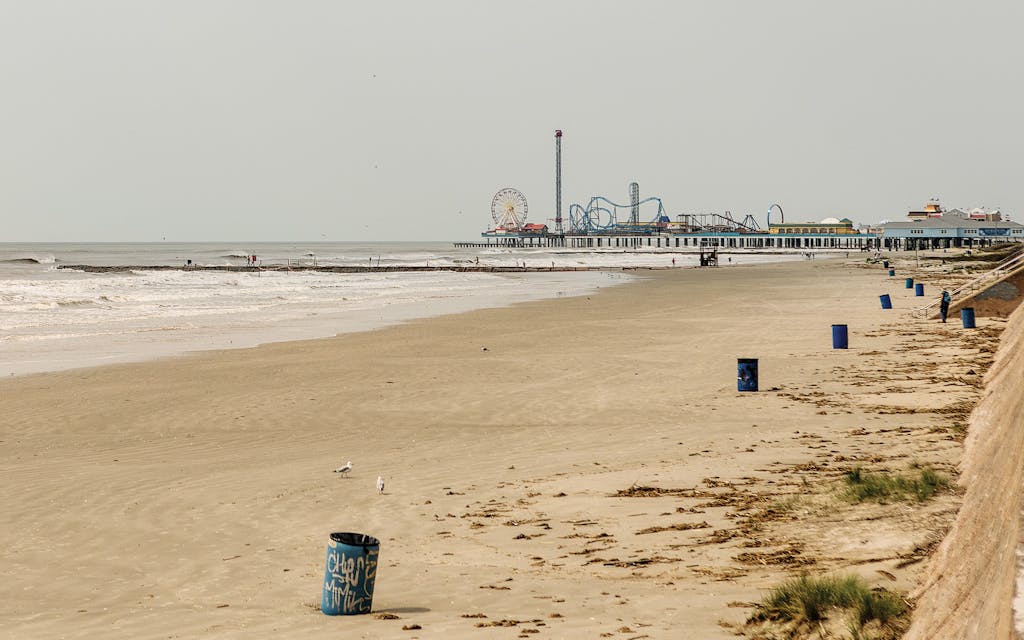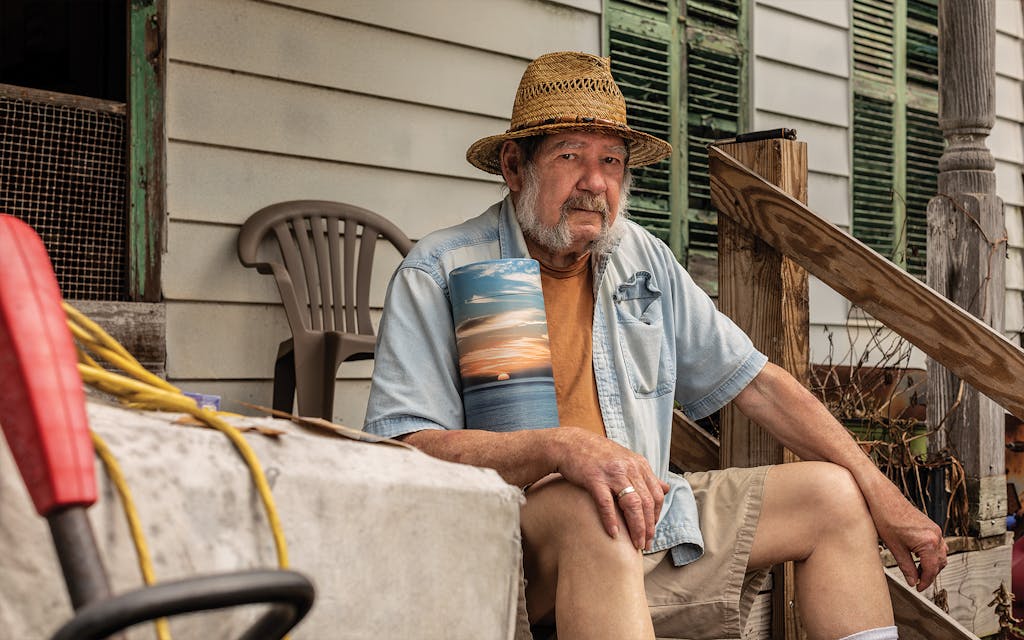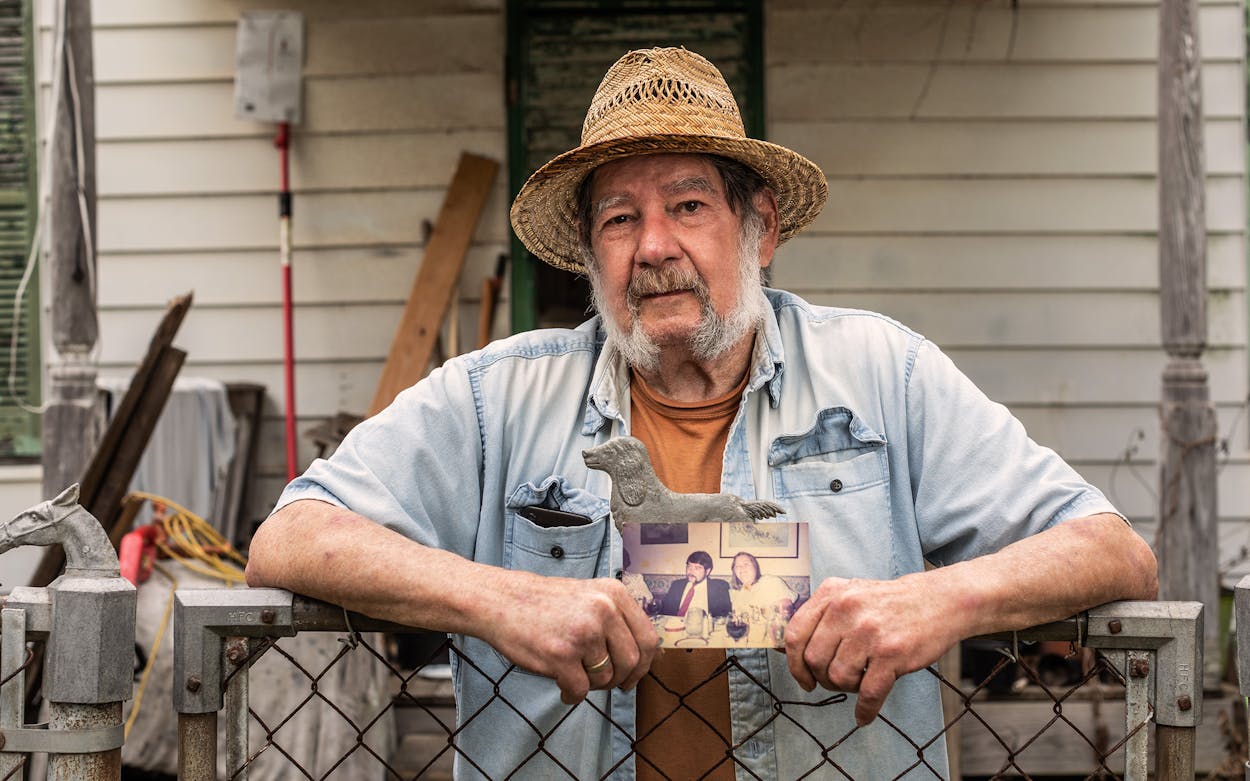Shirley Napier had a good Valentine’s Day. For that, Steven Napier is thankful. This year, he bought two boxes of Russell Stover chocolates to go with the card and the flowers. (One box for her. One for him.) “Women love flowers, and most women rarely get flowers,” Steven said. “Ten bucks for a dozen roses at Kroger. What the hell.”
That night, after celebrating their marriage of 38 years at Saltgrass Steak House and sampling the chocolates, the couple settled in for some late-night TV-watching, one of Shirley’s favorite pastimes. A winter storm was slowly sinking into Texas, and they planned to weather it in the living room of their small Galveston home, built just a year after the Great Storm of 1900, a massive hurricane that killed between 10,000 and 12,000 on the island and remains the deadliest natural disaster in American history. Like many of the homes around Galveston’s historic district, theirs was uninsulated. It was built to shed heat, not to retain it.
Still, the Napiers thought they were prepared. They cranked up six 1,500-watt electric space heaters, and as the arctic air rolled in, their house was comfortable at about 65 degrees. Shirley reclined on the living room couch. Steven sat in his La-Z-Boy until, around 2 a.m., the lights went out.
Outages happened every couple of months, and the power always returned before too long. They had no reason to expect otherwise this time. Shirley, at 68, relied on a walker because of her balance problems and bad knees. “We discussed it and decided it was just too risky trying to get her out to the car to get her warmed up, or to go get into a motel or something,” Steven said.
They had a generator on the porch, but Steven, a Marine Corps veteran who had owned a construction business on the island until COPD got the better of him, wasn’t sure he could get it started. “We decided our best plan of attack would be to put all the covers we could on the bed, get in the bed and snuggle, and then I’d work on the generator first thing in the morning.”
They went to bed at 3 a.m. At around 8:30 that morning, Shirley, wearing two full-length cotton nightgowns and a heavy robe, made her way to the bathroom. By then, Steven said, the temperature in the house was near freezing. Returning to bed, Shirley was badly chilled, her breathing labored. “I had her attempt to put the covers over her head and leave a space for some fresh air to get in,” said Steven. “That way she was breathing the body-warmed air, and her breathing was getting better.”


A neighbor phoned to check on them. Steven took the call in the kitchen, standing over a burner on the gas stove. “When I went back to the bedroom to check on her, she was laying there faceup with a peaceful look on her face. Her eyes were open and I called her name and got no response and I saw she wasn’t breathing.”
When the EMTs arrived, they shocked Shirley’s heart three times to get it beating and then rushed her the few blocks to the University of Texas Medical Branch hospital, where she was put on life support. Her temperature was 91.4 degrees, about 4 degrees below the threshold for hypothermia. Steven kept vigil by her side, joined by the couple’s daughter and grandson, who flew down from Milwaukee. The following Sunday, just as the snow and ice had finished melting, Shirley was removed from life support and took her last breath. According to the death certificate completed by the attending physician, Shirley had died of “hypoxic brain injury due to myocardial infarction, unspecified type”—a brain injury stemming from a heart attack.
Steven insists it was the brutal cold that killed his wife, that hypothermia caused her heart to fail. Her death was no act of God, he contends. Those who failed to plan for the storm, who failed to warn Texans about what was coming, should be held responsible. “This is Texas,” he said. “We ought to get a rope and start hanging those motherf—ers. A bunch of money-grubbing bastards.”
The governor and the Legislature are ultimately responsible for overseeing the electric grid in Texas. But Steven is unlikely to find much justice in Austin.
In the weeks after the storm, the state’s political leadership was consumed less by casualties than by a showy and furious debate over the financial fallout from the blackouts. During the storm, the state Public Utility Commission (PUC) had forced wholesale power prices to astronomical levels for days, even after the blackouts were largely over—a controversial and crude intervention that cost electric retailers, and ultimately their customers, an estimated $16 billion. In March, an independent market monitor for the PUC recommended that the agency “reprice” billions in what the monitor labeled improper overcharges. PUC chairman Arthur D’Andrea, recently appointed by Governor Greg Abbott, told lawmakers he had no authority to do so, leaving the issue up to them to decide.
But because the transactions would lock in after March 20, the Legislature, meeting in its biennial session, only had a narrow window to act. Lieutenant Governor Dan Patrick and the Texas Senate quickly passed a bill ordering the PUC to reprice. Amid this debate, D’Andrea joined a private conference call with Wall Street investors and assured them that he was working hard to protect their windfall profits. Just three hours after Texas Monthly broke the story about the meeting, Abbott forced D’Andrea’s resignation. But the investors and others who profited from the sky-high prices could rest easy. House Speaker Dade Phelan and the rest of his body, with Abbott’s tacit approval, refused to act on the repricing legislation. By mid-March, the issue was moot.
But for those whose loved ones died in the storm, the bigger issue was lives and how exactly they were lost. Joined by some local and state officials, they are now promising to hold the managers of the power grid responsible for the blackouts. High-profile attorneys are working with dozens of families to sue electric utilities around Texas as well as the Electric Reliability Council of Texas (ERCOT), the grid operator overseen by the PUC.
The outrage is particularly palpable in Galveston, where the vast majority of homes—many of them built for beach weather—went without power. In early March, Steven Napier filed a lawsuit in neighboring Harris County arguing that ERCOT and CenterPoint, a utility company that serves the Houston area, knew that they weren’t prepared for the storm—but instead of warning their customers, they “just turned the power off in the middle of the night and left people to die.”

In this, Steven, a Democrat, has found himself with an unlikely ally in Galveston County Judge Mark Henry, who in 2010 was elected the first Republican chief executive of the county since Reconstruction. In March, without fanfare, Henry filed a remarkable complaint asking the Galveston County district attorney to open an investigation into whether deaths in the county during the storm might warrant criminal charges against ERCOT, CenterPoint, Texas–New Mexico Power (which serves portions of Galveston County), or “their high managerial agents.”
CenterPoint and Texas–New Mexico Power said they mourned the lost lives, but declined to be interviewed by Texas Monthly. CenterPoint has pointed out that it does not generate power, and both companies have noted that they were following ERCOT’s orders to suspend service to some customers. ERCOT declined to comment.
“I have questions. My constituents have questions,” Henry wrote in his complaint. “The dead bodies are being counted and justice is required to answer whether any or all of those who died from this ordeal were the victims of murder, manslaughter, or criminally negligent homicide.”
At 1:25 a.m. on February 15, while the Napiers were watching an old western, Henry was at his home in nearby League City when he got the first official word from ERCOT about rolling blackouts. It came in the form of a tweet: “Rotating outages are underway to reduce demand on the electric system.”
The county’s Office of Emergency Management, which Henry directs, retweeted the news to its 11,600 followers, along with additional information that it had hurriedly gleaned from the utilities serving the county: the rolling blackouts could last anywhere from fifteen to thirty minutes. No sooner did that message go out than Henry received an email from CenterPoint; the utility was “attempting to limit the duration of each outage to less than one hour.” Both forecasts were dangerously wrong. “What happened was, power went off and it stayed off,” Henry said.
At the peak of the blackouts statewide, at 11 a.m. on Tuesday, February 16, 94 percent of Galveston County’s residents were without power, compared to 18 percent in Harris County and 44 percent in Travis County. Many of Henry’s constituents went 72 hours or more without heat in subfreezing temperatures.
Henry is most haunted by what Galvestonians, so accustomed to dealing with disasters, could have done if they had been warned what they were up against. Local officials could have ordered evacuations of the most vulnerable, as they do ahead of hurricanes. They could have texted every cellphone in the county with an alert. They could have set up shelters with emergency generators to power heaters. “I suspect,” Henry said, “that some of these people perished thinking, ‘Well, you know the power is gonna come back on in just a minute.’”
Part of the challenge in any accounting of the cost of the blackouts is simply inventorying the dead. The state’s counting is slow and methodical and depends on the quality of information provided by local officials and doctors, who are encouraged to alert the state health agency to disaster-related deaths. The agency also attempts to confirm public reports of disaster-related fatalities, including those in newspaper articles, with death records.
On March 25, the state issued its second report on winter-storm-related deaths. Most of the deaths were from hypothermia, but there were also fatalities from vehicle accidents on icy roads, carbon monoxide poisoning, medical equipment failures, falls, and fires. The report found 111 deaths in all—31 in Harris County, 9 in Travis County, 6 in Taylor County, and 4 or fewer in 43 other counties. Galveston County, the state reported, had 6. That figure roughly matched the findings of the Galveston County medical examiner, who has determined so far that the February crisis was the cause of 4 fatalities there and was a contributory cause in a fifth. One other suspected case is still under investigation. Those deaths form the basis of Henry’s criminal complaint, but both the local and state tallies may be an undercount.
For example, Henry and Galveston County chief medical examiner Erin Barnhart only learned of Shirley Napier’s death from Texas Monthly. Barnhart never had an opportunity to examine her body. “In hindsight this case should have been referred to our office,” Barnhart wrote me in an email. “I’m sure there are a lot of very similar cases out there.” And determining the role that a disaster may have played in any particular death is an inexact science. “To be honest, most of them are in gray areas,” Barnhart said.
In their report, Hitchcock police noted that there were “pots and buckets on the floor with frozen liquids inside” and that the man’s skin was “ice-cold to the touch.”
One of the more clear-cut cases involved a fifty-year-old man who died on February 16 in his home in Hitchcock, a small city on the mainland opposite Galveston. In their report, Hitchcock police noted that there were “pots and buckets on the floor with frozen liquids inside” and that the man’s skin was “ice-cold to the touch.” Those details gave Barnhart “a high index of suspicion” that enabled her to classify the cause of death as “environmental exposure, due to Feb. 2021 winter storm.”
But a second death in Hitchcock the same day was not among those on the medical examiner’s list of storm-related deaths. Eula Stevens Piangenti was a BOI (“born on the island”) resident of Galveston who had spent most of her 89 years in the same neighborhood as the Napiers. Piangenti had been in hospice for about two months at the time of the blackouts, living out her final days in the home of her eldest daughter, Sharon Stacy. Piangenti couldn’t walk because of arthritis and had been sinking into dementia. Her breathing had grown rapid, and two weeks earlier, she had been advised to use supplemental oxygen while sleeping. The power went out at Stacy’s home around 9:30 on the morning of February 15. “She was without oxygen, and it was just extremely cold. We had about five blankets on her and a beanie hat, but it was freezing in the house,” Stacy said.
When the power came back on eighteen hours later, Piangenti’s electric-powered oxygen machine restarted, and she seemed in decent shape. But when her family looked in on her around 8:15 a.m., she had died. Because of icy roads, the hospice nurse couldn’t come to the house. A week later, the hospice medical director certified the immediate cause of death as Alzheimer’s and the underlying cause as hypertensive heart disease. A section on the death certificate for “significant conditions contributing to death” was left blank, with no mention of the events that preceded it.
“I thought she was at least going to live another four or five or six months,” Stacy said. “So we weren’t expecting it. It wasn’t like she was on her last breath and she got cold. She wasn’t on her last breath. She was still functioning.”

For those such as Steven Napier who are grieving victims of the blackouts, Henry’s invocation of “negligent homicide” is apt and satisfying, even if the chances of anyone ever serving jail time are slim. Galveston County district attorney Jack Roady’s office has said little about the complaint, other than that he is investigating every death that occurred during the storm and will proceed if there is “probable cause that a criminal violation occurred.”
Two other Texas law enforcement figures have opened criminal investigations—Bexar County Sheriff Javier Salazar and Travis County district attorney José Garza. Though experts caution that very few disaster-related criminal investigations of corporate wrongdoing result in charges and convictions, such inquiries carry special weight. “There’s sort of this expressive power of the criminal law. It says something is really, really, really, really bad in a way that a civil sanction does not necessarily,” said James Anderson, director of the Justice Policy Program at the RAND Corporation, a nonprofit think tank.
In a notable case, utility giant Pacific Gas & Electric pleaded guilty last June to 84 counts of involuntary manslaughter because its transmission lines sparked the 2018 Camp Fire, California’s deadliest wildfire. But the company had to pay only $3.5 million in fines as part of its plea. The judge, noting his hands were tied, said that if PG&E were an “actual human person,” the sentence would have been ninety years in prison. Formal criminal proceedings against corporations are “very rare,” Anderson wrote in a 2014 report. “Almost no one is incarcerated, and the most common outcome is some kind of company-funded compliance program—a de facto fine.”
But for attorneys seeking civil redress, criminal investigations “add another level of oomph” to lawsuits, said Houston trial lawyer and former mayoral candidate Tony Buzbee. He has filed thirty wrongful-death suits related to the storm, including in the case of eleven-year-old Cristian Pineda, who died in his family’s freezing Conroe mobile home after playing in the snow for the first time. Buzbee and other civil litigators “have a hell of a lot more resources than Jack Roady does, but Jack Roady has the imprimatur of the state on his side,” Buzbee said. “No company likes a DA investigating them. And sometimes that leads to a quicker resolution on the civil side when that happens.”
Even though criminal charges may be hard to come by, Galveston authorities feel compelled to act. “People here are very self-sufficient,” said Patrick Gurski, an attorney on the island who helped craft the criminal complaint. “There’s a certain mindset that if you’re going to live here, you know that you may be on your own sometimes.” But self-sufficiency, he says, has its limits, even for disaster-hardened Galvestonians. When a hurricane starts churning toward them from the Gulf, there’s usually plenty of warning. For the victims of these deadly blackouts, there was none.
This article originally appeared in the May 2021 issue of Texas Monthly with the headline “Cold Justice.” Subscribe today.
- More About:
- Winter Storm 2021
- Galveston







